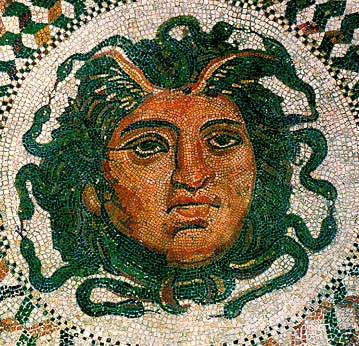
The face famous for turning men to stone is itself made of stone in this third-century A.D. mosaic, found in the Roman baths at Henchir Thina, in Carthage. The Gorgon Medusa, mythology’s most feared enchantress, was a popular subject on mosaics throughout the Roman world for many centuries—mosaics featuring her head have been found from North Africa to Italy to Spain, some as early as the first and second centuries A.D. and even continuing to the present day.
This Carthaginian Medusa, with the ubiquitous snakes hissing through her hair and two small wings sprouting from her forehead, makes use not only of the white and black stones favored by mosaicists in Italy but uses the yellows and reds readily found in the marble quarries around Tunisia as well.
The mosaic art form has a long history. Mosaics featuring figures, animals or designs (rather than random patterns) appear in the late fifth century B.C. in cities of the Greek world; pebble mosaics are the earliest examples. These continued in use even as other forms gained in popularity—in particular tessera mosaics from the third century B.C., which employed very small cubes of stone or glass (tesserae) useful for geometric patterns and figure compositions. Tessera mosaics remained popular through the early Christian period.
Already a library member? Log in here.
Institution user? Log in with your IP address.

